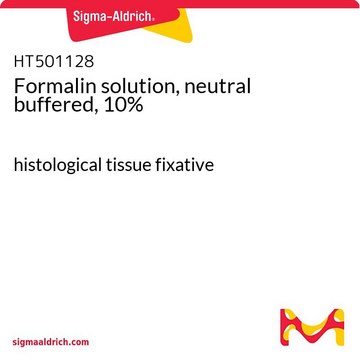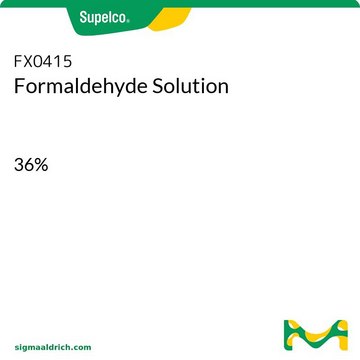15512
Formaldehyde solution
meets analytical specification of USP, ≥34.5 wt. %
Synonym(s):
Formalin
About This Item
Recommended Products
vapor density
1.03 (vs air)
Quality Level
vapor pressure
52 mmHg ( 37 °C)
autoignition temp.
572 °F
quality
meets analytical specification of USP
contains
9.0-15.0% methanol as stabilizer (GC)
concentration
≥34.5 wt. %
25-50%
impurities
acidic reac. substances, complies
residual solvents, complies
ign. residue
≤0.01% (as SO4)
density
1.09 g/mL at 25 °C (lit.)
suitability
corresponds for identity
SMILES string
[H]C([H])=O
InChI
1S/CH2O/c1-2/h1H2
InChI key
WSFSSNUMVMOOMR-UHFFFAOYSA-N
Looking for similar products? Visit Product Comparison Guide
Related Categories
General description
Application
Other Notes
The article number 15512-6X1L-R will be discontinued. Please order the single bottle 15512-1L-R which is physically identical with the same exact specifications.
Signal Word
Danger
Hazard Statements
Precautionary Statements
Hazard Classifications
Acute Tox. 2 Inhalation - Acute Tox. 3 Dermal - Acute Tox. 3 Oral - Carc. 1B - Eye Dam. 1 - Muta. 2 - Skin Corr. 1B - Skin Sens. 1 - STOT SE 1 - STOT SE 3
Target Organs
Eyes,Central nervous system, Respiratory system
Storage Class Code
6.1A - Combustible acute toxic Cat. 1 and 2 / very toxic hazardous materials
WGK
WGK 3
Flash Point(F)
143.6 °F - closed cup
Flash Point(C)
62 °C - closed cup
Choose from one of the most recent versions:
Already Own This Product?
Find documentation for the products that you have recently purchased in the Document Library.
Customers Also Viewed
Our team of scientists has experience in all areas of research including Life Science, Material Science, Chemical Synthesis, Chromatography, Analytical and many others.
Contact Technical Service







